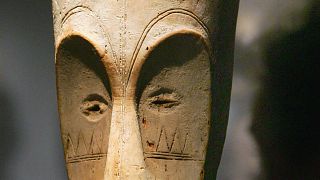Vatican
Blue and white majolica vases in different shapes and sizes form part of a new collection at The Vatican Museum.
Used by nuns at a historic Rome pharmacy, these artefacts are now being showcased in two rooms: the “Spezieria di Santa Cecilia in Trastevere” (Apothecary shop of St. Cecilia in Trastevere) and the “Sala Delle Ceramiche” (Ceramics Hall).
“In the last few days, we have opened two new rooms in the Vatican Museums to the public for the first time. They will be part of the (exhibition) route from the exit of the Sistine Chapel to our decorative arts department. These are two extraordinary, unusual and unexpected rooms. In the first one, where we are now, you can see the pharmacy of Santa Cecilia in Trastevere, the ancient apothecary's shop, reconstructed and rearranged with all the original objects. The majolica set of apothecary objects , the furniture, the containers and, above all, the ingredients still contained inside the jars, which makes this complex, truly unique and extraordinary,” says Luca Pesante, archaeologist in the Decorative Arts Department.
Ingredients such as animals bones and tools that were used to make medicines fill the Spezieria di Santa Cecilia in Trastevere.
Artefacts such as containers, glassware, and objects dating back to the 17th century have been preserved explains Pesante.
Cabinets, chests of drawers, presses, boxes and glass and ceramic apothecary jars containing spices, ointments, and herbal remedies were left by the Benedictine nuns who ran the pharmacy.
After the nuns moved location, the pharmacy stopped operating - preserving precious decorated vases and ingredients once used to make medicines.
The ancient apothecary, one of the most complete in Italy, was established inside the Monastery of Santa Cecilia in Trastevere, adjacent to the basilica, by Cardinal Paolo Emilio Sfondrati, who governed the Basilica and the Monastery from 1560 to 1618.
The monastery was a vibrant economic hub: it owned fishponds and grain mills on the Tiber, kilns, gardens and land.
In 1936, in order to prevent its dispersion, the entire collection was transferred to the Vatican Apostolic Library, and then in 1999 it was transferred to the Vatican Museums in the Department of Decorative Arts.
“This transfer froze the still-operating pharmacy in time, so much so that we find containers, crockery, glassware, objects from the first decades of the 17th century - when Cardinal Paolo Emilio Sfrondati invested in the new supply of goods to the Benedictine monastery - and objects from the first decades of the 20th century, from the last century, crockery of various origins with ingredients inside them", says Pesante
The “Spezieria” was once located in the picturesque Roman neighborhood of Trastevere - it has been recreated in the museum that also features the Sistine Chapel.
“Undoubtedly, among the most interesting objects in the Spezieria is the majolica set of apothecary objects that you can see behind me. The cobalt blue painted majolica collection with the inscription on the front of the vases containing the name of the medicine, there is the complete series of water jars, which are the larger ones you can see on the bottom shelf and some of those on the top shelf, and the complete series of syrup jars,” explains Pesante.
Many of the majolica (glazed) objects preserved were made by master potters using kilns and workshops owned by the monastery itself.
Monastery documents, kept in the state archives in Rome, give a detailed account of its purchases and commissions from craftsmen, potters, glassmakers and suppliers.
The documents provide an insight into the activities of the monastery and the 'Spezieria' on a day-to-day basis.
Ceramic saucers inscribed with the initials of nuns were used to prepare medicines from a wide variety of plants and ingredients which are preserved in vases, drawers and bottles.
A door inside the former apothecary's shop leads to the second room, the “Hall of Ceramics”, which houses for the first time in its entirety the Vatican's collection of medieval and modern ceramics.
The permanent collection is one of the most significant on display in Italy.
One thousand years of the history of Italian ceramics are represented here, the variety of objects include finds from excavations in St. Peter's Square.
It also has part of an ancient floor from the Vatican Loggias, drawn by the great Italian artist Raphael, as well as 34 precious Renaissance plates from the Carpegna Collection.
“What we have behind me is probably one of the most empathic collections, the Renaissance collection of dishes and ceramics. But there is much much more, much much more - telling about the different aspects of society, of Italian society through these 10 centuries of life. (For example,) Floors of the Loggia of Raphael, with the design of Raphael, floor with incredible ceramics of the Borgia apartment,” explains Barbara Jatta, director of the Vatican Museums.
The “Spezieria”, one of about 80 that existed in Rome, provided health care, in particular, for the 60 or so nuns of the monastery, as well as, the same 200 people who worked for the monastery, from the artisans to bursars and priests.
“The excavations in the Vatican City State, the tiniest state of the world but still so rich underneath. So each excavation, of course, in this tiny state products, artifacts that tells a story of our state, of our society, of our memories and so it’s important to share, exactly what we are doing now in these two rooms,” says Jatta.












02:18
New York research centre celebrates 100 years of documenting Black culture
02:21
Peruvian victims of abuse by Catholic group want Pope Leo, US to intervene
00:42
UN releases Palace Museum centennial stamps
01:00
Pope Leo XIV calls for the release of imprisoned journalists
01:00
Pope Leo XIV reopens sealed papal apartment but will he live there?
01:53
Pope Leo XIV calls for release of imprisoned journalists